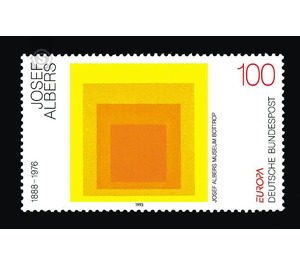Europe - Germany / Federal Republic of Germany 1993 - 100 Pfennig
Theme: Art & Culture
| Country | Germany / Federal Republic of Germany |
| Issue Date | 1993 |
| Face Value | 100.00 |
| Color | yellow white |
| Perforation | K 13 3/4: 14 |
| Printing Type | Multicolor offset printing |
| Stamp Type | Postage stamp |
| Item Type | Stamp |
| Chronological Issue Number | 1547 |
| Chronological Chapter | GER-BRD |
| SID | 815404 |
| In 29 Wishlists | |
Josef Albers, born on March 19, 1888 in Bottrop, internationally known as the father of "optical art" since the mid-sixties, was an elementary school teacher in Bottrop from 1908 to 1919 before deciding to study art and after a first Studied 1913-1915 at the Royal School of Art in Berlin 1920 to the recently founded by Walter Gropius Bauhaus to Weimar. After completing his apprenticeship, he led successively from 1923 the glass workshop, the furniture workshop and finally from 1932 as Bauhaus master the preliminary course. After the forced closure of the Bauhaus in 1933 by the Nazis, Josef Albers emigrated with his wife to the United States, where he found a new sphere of activity at Black Mountain College in North Carolina. Teaching activities at famous universities such as Harvard, Princeton, Yale and other institutes in the USA followed. Many awards, prizes and honors were given to him, including 14 honorary doctorates from American and German universities alone. His pictures have been shown at numerous exhibitions in the most important museums in the world; In 1971 he was the first living artist to be given a solo exhibition at the Metropolitan Museum of Art in New York. His works are represented in the most important museums and collections. When Josef Albers died on March 25, 1976 in Orange / Connecticut, he had gained worldwide recognition as a painter of the paintings that became famous under the name "Homage to the Square". In this series of Homage to the Square, Josef Albers explores the diverse relationships between colors. These interactions of color are also the basis of his investigations of 1963 published under the title "Interaction of color" and published to date in eight languages translated publication in which he describes an experimental method to study the subject color and teach. (Text: Dr. Ulrich Schumacher, Josef Albers Museum Square, Bottrop)


